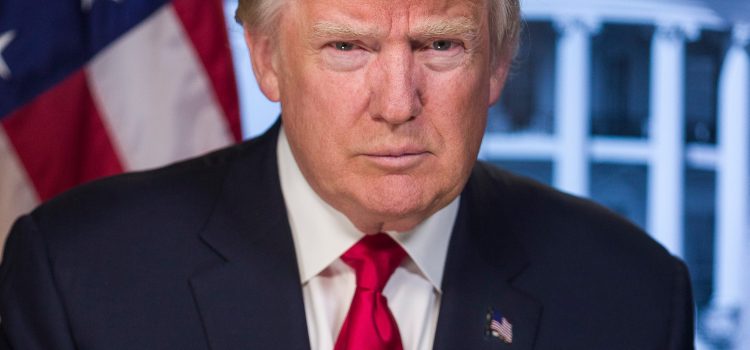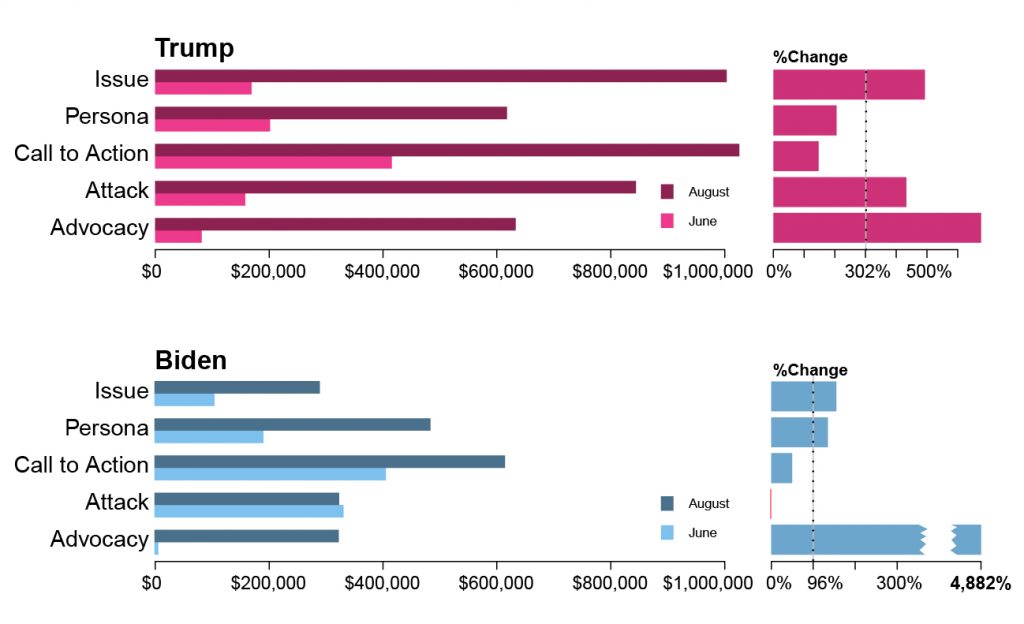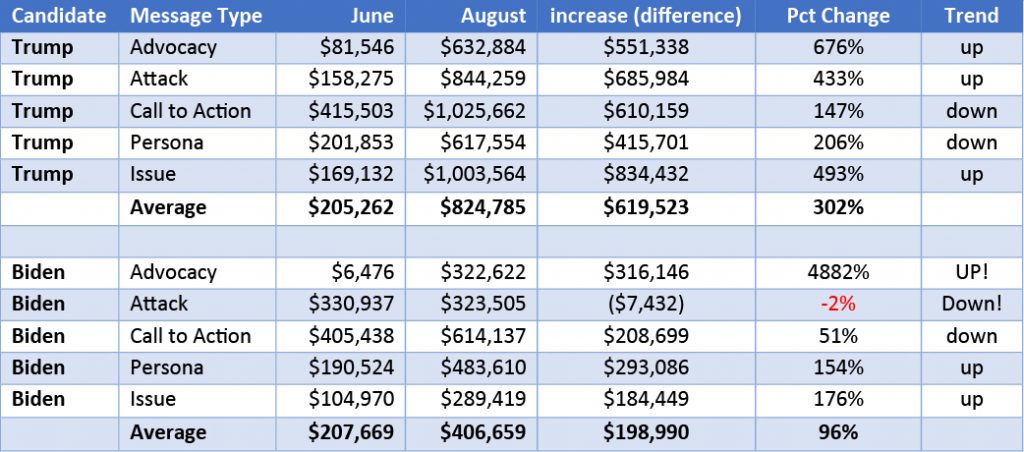
By Jeff Hemsley
This post was updated on 10/26/2020. The original post underestimated spending by the Biden campaign. Estimates for spending by the Biden campaign were updated throughout the post, including text and figures.
Biden has maintained a fairly consistent national polling lead of around 7 to 8% since mid June, but Trump’s standing in the race has tightened in certain key battleground states. For example, according to FiveThirtyEight, Biden had a polling lead of approximately 7% in Florida mid June, but his lead has dropped to 1.8% as of September 29. With respect to Facebook ads that target residents of Florida, we wondered: Has the Trump campaign changed its advertising strategies between mid June and September? And if so, how have the Trump campaign’s changes compared to any changes in the Biden campaign’s strategies?
To answer these questions, we turn to the Illuminating project’s Facebook ad data. We look specifically at message type, which reflects the function(s) of candidates’ messages. Attack messages, for instance, critique a target—such as the candidate’s opponent—while messages that contain a call to action may ask people to donate money, click a link, or watch a video. (For more information about our message type classifiers, please click here.)

First, while Biden has increased his spending for each message type, Trump has increased his spending dramatically more. The analysis is somewhat complicated by the fact that ads can be categorized as more than one message type. However, utilizing the data from Illuminating, we can do some additional calculations: we can find the average spending on all message types in June and August for each candidate and compare those. So, for example, Biden’s campaign spent an average of $207,669 across the five message types during the month of June in Florida, which increased to an average of $406,659 August: an increase of 96%. But Trump’s spending in Florida increased from a June average of $205,262 to an August average of $824,785: an increase of 302%.
Of course, Trump’s increases in spending were not even across all five message type categories. That is, some categories saw spending increases greater than average, while others did not. By looking at which categories’ spending increased more (or less) than the collective average of 302%, we can get a sense of changing campaign priorities.
Trump’s spending on advocacy messaging increased the most dramatically: he spent 676% more money on ads that advocated for himself or his policies in August. Trump’s spending on attack ads against Biden increased by 433%. And finally, his spending on issue-focused ads increased 493% between June and August.

Note that Trump’s spending on advocacy, attack and issue messaging all increased by more than the average increase of 302% across all message categories. Conversely, spending on call to action and persona messaging increased less than the average increase across all categories. These changes reflect a rebalancing in messaging strategy—more emphasis on some message types at the expense of others. And while we can’t definitively link these changes to Trump’s improved polling in Florida, they nevertheless provide some food for thought.
So what about Biden?
While the Trump campaign increased its spending in Florida by over 300% between June and August, the Biden campaign’s overall spending only increased by 96%, based on the change in the average across all categories. The Biden campaign de-emphasized calls to action and attack; calls to action increased by only 51% and spending on attacks actually dropped 2%, both of which are much less than the average increase of 96%. In contrast, Biden’s spending on ads classified as persona and issue increased by 154% and 176% respectively, more than the average and so these appear to be a higher priority in August for the Biden campaign.
The most notable shift in the Biden campaign’s spending priorities was in its advocacy messaging, where spending increased by 4,882%. That sounds like a big number, and in terms of change in strategy it is huge, but Biden only spent $6,476 on advocacy messaging in June, which increased to $322,622 in August. This puts Biden’s spending on advocacy at about the same amount as he spent on attack in August: $323,505.
It might be easy to think that if the Biden campaign prioritized attack and issue ads like the Trump campaign, then Biden might regain his lead in the polls in Florida. However, we have to remember that the candidates’ campaigns have different target audiences; messaging that works for one group might not work for another. Overall, both campaigns increased spending, but they did so unevenly. Some types increased a lot – far more than the average increase – and some types increased only a bit (or even dropped), not nearly as much as others. By looking at the Illuminating 2020 data, we see that there is a re-balancing of ad strategy taking place, as both campaigns are trying their best to find their “sweet spot” of message type targeting potential voters in important battleground states.
All spending and impression amounts are estimates based on data provided by the Facebook Ad Library API. Feature photo by Library of Congress on Unsplash
